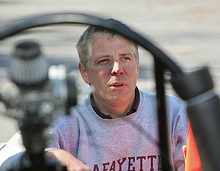Honor from ASTM International establishes mechanical engineering professor as one of the world’s leading experts in area of galling wear
 ASTM International has awarded Scott Hummel, associate professor and head of mechanical engineering, the Frank C. Brautigam Award for outstanding and effective work as a task group chairman in the development of a new ASTM standard in the area of galling (metal on metal) wear. This establishes Hummel as one of the world’s leading experts in this field.
ASTM International has awarded Scott Hummel, associate professor and head of mechanical engineering, the Frank C. Brautigam Award for outstanding and effective work as a task group chairman in the development of a new ASTM standard in the area of galling (metal on metal) wear. This establishes Hummel as one of the world’s leading experts in this field.
Founded in 1898, ASTM International (formerly the American Society for Testing and Materials) is one of the largest voluntary standards development organizations in the world. Each year, it publishes a 76-volume book of more than 11,000 industry standards. These technical documents are a basis for manufacturing, management, procurement, codes, and regulations.
Among these 11,000 standards is ASTM G196, the Standard Test Method for Galling Resistance of Material Couples, developed by Hummel. During the 10 years that Hummel conducted the standard research, Lafayette students, including Ryan Waite ’05, Ben Partlow ’03, and Alex Herr ’00, contributed to the project and were co-authors on papers published by Hummel.
Galling is a severe form of wear that can occur when the surfaces of metal components slide across one another. This kind of wear can lead to failure of mechanical equipment. The standard that Hummel developed has advantages, including improved accuracy, over the previous standard used to determine a material’s propensity to gall.
ASTM standards are developed by members who serve on committees that cover a subject area such as steel, petroleum, medical devices, property management, consumer products, and many more. Hummel is the chairperson of ASTM’s technical committee on wear and erosion. He was recently re-elected to serve in the position through 2011. The committee has jurisdiction over approximately 25 international standards that cover all aspects of wear and erosion analysis and methods of testing.
In order for the new standard to be put into place, it was subjected to a rigorous process that included review by all of the more than 85 members of the wear and erosion committee.
“When a test method is standardized, the entire community of experts in the field is stating that the test method is the best method of determining the material properties. It is an endorsement of the test method as the current state-of-the-art,” Hummel says.
